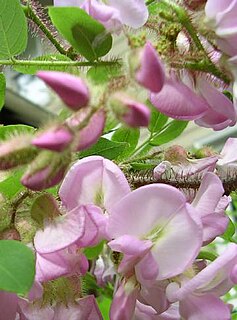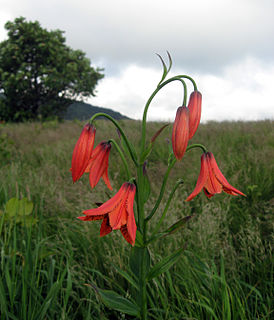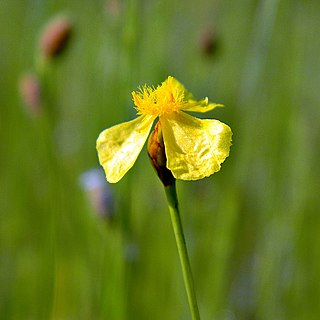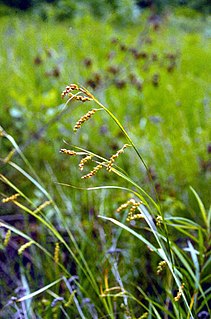
Quercus bicolor, the swamp white oak, is a North American species of medium-sized trees in the beech family. It is a common element of America's north central and northeastern mixed forests. It can survive in a variety of habitats. It forms hybrids with bur oak where they occur together in the wild.

Allium tricoccum is a flowering plant species is a North American species of wild onion widespread across eastern Canada and the eastern United States. Many of the common English names for this plant are also used for other Allium species, particularly the similar Allium ursinum, which is native to Europe and Asia.

Stachys is one of the largest genera in the flowering plant family Lamiaceae. Estimates of the number of species in the genus vary from about 300, to about 450. The type species for the genus is Stachys sylvatica. Stachys is in the subfamily Lamioideae. Generic limits and relationships in this subfamily are poorly known.

Robinia hispida, known as the bristly locust, rose-acacia, or moss locust, is a shrub in the subfamily Faboideae of the pea family Fabaceae. It is native to the southeastern United States, and it is present in other areas, including other regions of North America, as an introduced species. It is grown as an ornamental and can escape cultivation and grow in the wild.

Ulmus crassifoliaNutt., the Texas cedar elm or simply cedar elm, is a deciduous tree native to south central North America, mainly in southern and eastern Texas, southern Oklahoma, Arkansas and Louisiana, with small populations in western Mississippi, southwest Tennessee and north central Florida; it also occurs in northeastern Mexico. It is the most common elm tree in Texas. The tree typically grows well in flat valley bottom areas referred to as 'Cedar Elm Flats'. The common name 'cedar elm' is derived from the trees' association with juniper trees, locally known as cedars.

Trillium catesbaei, also known as bashful trillium, Catesby's trillium, or bashful wakerobin, is a species of flowering plant in the family Melanthiaceae. It is found in the southeastern United States where its northern limit includes the Great Smoky Mountains and other parts of North Carolina and Tennessee. Its southernmost natural occurrence is in Escambia County, Alabama. Most of its populations are in the Piedmont from North Carolina to Alabama, under deciduous trees such as American beech, various oak and hickory species, and tulip poplar. Like most trilliums, it prefers moist, humus-rich soil in shade.

Coreopsis delphiniifolia, the larkspurleaf tickseed, is a North American species of perennial tickseeds in the sunflower family. It is native to the Southeastern United States, primarily Georgia and the Carolinas with a few outlying populations in Tennessee and Virginia. It is listed as an endangered species in Tennessee.

Stachys chamissonis is a species of flowering plant in the mint family known by the common name coastal hedgenettle. It is native to the west coast of North America, where it grows in moist coastal habitat from Alaska to central California. This mint produces an erect stem 1 to 2 1⁄2 meters. It is hairy, glandular, and aromatic. The oppositely arranged leaves have pointed, wavy-edged blades up to 18 centimeters (7.1 in) long which are borne on petioles. The hairy, glandular inflorescence is made up of interrupted clusters of up to six flowers each. The flower has a deep pink tubular corolla which can be over 3 centimeters (1.2 in) long. The corollas are borne in hairy calyces of purple or purple-tinged sepals.

Lilium grayi is a perennial plant that is endemic to the eastern US states of North Carolina, Virginia, and Tennessee, growing in moist, acid soil in the Appalachian mountains on higher elevation meadows, bogs, and seeps. The plant was introduced to Royal Botanic Gardens, Kew in 1890 and was featured in the Kew Bulletin in 1892.
Calycocarpum (cupseed) is a monotypic genus of plants in the family Menispermaceae. The only species currently accepted is Calycocarpum lyonii endemic to the southeastern United States.
Stachys manantlanensis is a plant species endemic to the Mexican State of Jalisco. It grows in mountainous areas in the Rincón de Manantlán west of Guadalajara at elevations of 1900–2200 m.

Leavenworthia uniflora, called Michaux's gladecress or one-flowered gladecress, is a plant species native to the southeastern and Midwestern parts of the United States. It is reported from northwestern Georgia, northern Alabama, Tennessee, northern Arkansas, southern Missouri, Kentucky, southeastern Indiana and southwestern Ohio. It grows in open, sun-lit locations at elevations less than 500 meters.

Helianthus eggertii, known as Eggert's sunflower, is a North American species of flowering plants in the sunflower family. It is native to Tennessee, Kentucky, South Carolina, and Alabama. It is best known as one of the few plants to have been delisted under the Endangered Species Act because of the species' recovery. It was described by John Kunkel Small in 1903.

Elephantopus carolinianus, common names Carolina elephantsfoot or leafy elephant's foot, is a species of flowering plant in the sunflower family. It is native to the United States from Florida north as far as Ohio, Illinois, and Pennsylvania, west to Texas, Oklahoma, and Kansas.
Eupatorium godfreyanum, commonly called Godfrey’s thoroughwort, is a North American species of plants in the sunflower family. It is found in the east-central United States, primarily from Pennsylvania to North Carolina, with a few isolated populations west of the Appalachians in Ohio, Kentucky, and Tennessee.

Helianthus porteri is a species of sunflower known by the common names Porter's sunflower, Stone Mountain daisy and Confederate daisy. It is native to the southeastern United States, such as Alabama and Georgia, but has been introduced to granite outcrop areas in North Carolina where it is aggressively weedy.

Xyris difformis, the bog yelloweyed grass, is a North American species of flowering plant in the yellow-eyed-grass family. It is native to the eastern and southern United States, eastern and central Canada, and Central America.

Triadenum fraseri known as bog St. John's wort, Fraser's St. John's wort, and Fraser's marsh St. John's wort, is a perennial flowering plant in the family Hypericaceae that is grows in wetlands of the northeastern and northcentral United States and lower Canada. It is named after John Fraser (1750–1811), a Scottish botanist and widely travelled plant collector.

Carex davisii, known as Davis' sedge or awned graceful sedge, is a species of Carex native to North America. It is listed as an endangered, threatened, or species of concern across much of edge of its range. It was named in the 1820s by Lewis David de Schweinitz and John Torrey in honor of Emerson Davis (1798–1866), a Massachusetts educator and "enthusiastic student of the genus" Carex.

Hypericum frondosum, the cedarglade St. Johnswort or golden St. John's wort, is a species of flowering plant in the St. John's wort family, Hypericaceae. It is native to the central and southeastern United States in dry, rocky habitats.


















